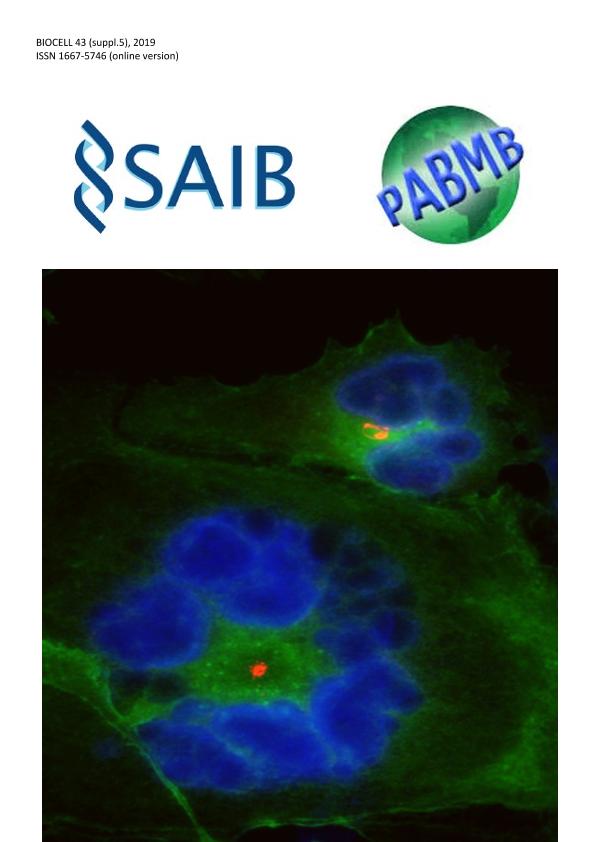Evento
Effect of foliar application of phosphites in "hayward" kiwifruit in storage and shelf life: analysis of pectin composition
Rivas Velasquez, Manuel de Jesus ; Paz, Cosme Daniel
; Paz, Cosme Daniel ; Dal Lago, Claudia Cristina; Martínez Noël, Giselle María Astrid
; Dal Lago, Claudia Cristina; Martínez Noël, Giselle María Astrid ; Yommi, A. K.; Andreu, Adriana Balbina
; Yommi, A. K.; Andreu, Adriana Balbina
 ; Paz, Cosme Daniel
; Paz, Cosme Daniel ; Dal Lago, Claudia Cristina; Martínez Noël, Giselle María Astrid
; Dal Lago, Claudia Cristina; Martínez Noël, Giselle María Astrid ; Yommi, A. K.; Andreu, Adriana Balbina
; Yommi, A. K.; Andreu, Adriana Balbina
Tipo del evento:
Reunión
Nombre del evento:
LV Annual Meeting Argentine Society for Biochemistry and Molecular Biology y XIV Annual Meeting Argentinean Society for General Microbiology
Fecha del evento:
05/11/2019
Institución Organizadora:
Sociedad Argentina de Investigaciones Bioquimicas;
Título de la revista:
Biocell
Editorial:
Sociedad Argentina de Investigaciones Bioquímicas
ISSN:
0327-9545
Idioma:
Inglés
Clasificación temática:
Resumen
The kiwifruit (Actinidia chinensis var chinensis cv. Hayward), a climacteric fruit, can be harvested at physiological maturity and maintain its quality for up to six months at cold storage. The length of the storage period depends, among others, on cell wall composition and structure, which impacts on texture and softening. Indeed, solubilization and degradation of pectins occur during fruit softening, leading to disintegration of the cell wall. Pectin is a complex heterogeneous polymer that can have different interactions within the cell wall as free pectin, bound to starch, attached by calcium bridges and bound to cellulose via hydrogen bonds. The phosphites activate the synthesis of compounds that reinforce cell walls, like pectin and lignin. The aim of this work was to study the effect of foliar application of phosphite on pectin composition in cold storage and shelf life. Plants were foliar sprayed (six weekly applications) 100 days after blooming, with 0.3% potassium phosphite (KPhi; 30% P2O5, 20% K2O) or water (Control). Fruits were harvested at physiological maturity and stored for 5 and 6 months (5M and 6M) at 0°C and 90-95% RH. Kiwifruit was analyzed at the end of each storage period (ES) and its shelf life (SL, 7 day at 20°C). Samples of outer pericarp tissue were frozen and ground using liquid N2. A chemical solvent method was used to successively extract cell walls and determine the composition of pectin. The cell wall material (CWM) was obtained by the enzymes inactivation with a mixture of phenol:acetic acid:water (PAW) and water soluble pectin fraction (W-SP) was recovered. To remove the kiwifruit starch and extract their bound pectin (S-SP), a solution of dimethyl sulfoxide was used. The Na2CO3 was added to obtain the pectin attached by tightly bonds and calcium bridges (C-SP). Each extract was dialysed 5 days, lyophilized and weighed. The results showed that KPhi treatment increased the yields of total pectins respect to the Control and also resulted lower at 5M respect to 6M of storage. At shelf life, pectin yield decreased in all treatments compared to end of storage. The yield of W-SP fractions was lower in SL than in ES, and resulted highest in KPhi treatment at 6M. The yield S-SP fraction was lowest in KPhi and in SL. This could be due to the enzymatic degradation of starch. The proportion of C-SP yield also was lower in KPhi but was higher in SL. The yield of CWM decreased from the 5M to 6M and increase at SF with the application of KPhi. These results suggest that KPhi treatment promote the pectin biosynthesis and their release in shelf life. After 5-6 months of cold storage, Hayward kiwifruit enters in its last ripening/over-ripening stage related to senescence, led by cell wall disintegration. In conclusion, KPhi treatment is suggested to be used in order to maintain the firmmess Hayward kiwifruit, at least until 5 months in cold storage prior shelf life and its consumption.
Palabras clave:
PHOSPHITES
,
KIWIFRUIT
,
STORAGE
,
SHELF LIFE
,
PECTIN
Archivos asociados
Licencia
Identificadores
Colecciones
Eventos(INBIOTEC)
Eventos de INSTITUTO DE INV. EN BIODIVERSIDAD Y BIOTECNOLOGIA
Eventos de INSTITUTO DE INV. EN BIODIVERSIDAD Y BIOTECNOLOGIA
Citación
Effect of foliar application of phosphites in "hayward" kiwifruit in storage and shelf life: analysis of pectin composition; LV Annual Meeting Argentine Society for Biochemistry and Molecular Biology y XIV Annual Meeting Argentinean Society for General Microbiology; Salta; Argentina; 2019; 139-139
Compartir



